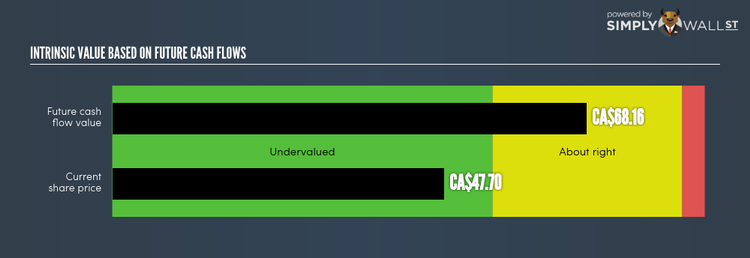If You Bought Laurentian Bank of Canada (TSE:LB) Today, There May Be An Upside

One of the most difficult industry to value is banking, given that they adhere to different rules compared to other companies. For instance, banks must hold a certain level of cash reserves on the books as a safety precaution. Focusing on elements like book values, as well as the return and cost of equity, may be suitable for estimating LB’s true value. Below I’ll take you through how to value LB in a fairly accurate and uncomplicated method. View our latest analysis for Laurentian Bank of Canada
What Is The Excess Return Model?
Financial firms differ to other sector firms primarily because of the kind of regulation they face and their asset composition. Strict regulatory environment in Canada’s finance industry reduces LB’s financial flexibility. Moreover, banks usually do not possess large amounts of physical assets as part of total assets. While traditional DCF models emphasize on inputs such as capital expenditure and depreciation, which is less useful for a financial stock, the Excess Return model focuses on book values and stable earnings.
Deriving LB’s Intrinsic Value
The main assumption for this model is that equity value is how much the firm can earn, over and above its cost of equity, given the level of equity it has in the company at the moment. The returns in excess of cost of equity is called excess returns:
Excess Return Per Share = (Stable Return On Equity – Cost Of Equity) (Book Value Of Equity Per Share)
= (11.44% – 9.85%) * CA$56.55 = CA$0.9
Excess Return Per Share is used to calculate the terminal value of LB, which is how much the business is expected to continue to generate over the upcoming years, in perpetuity. This is a common component of discounted cash flow models:
Terminal Value Per Share = Excess Return Per Share / (Cost of Equity – Expected Growth Rate)
= CA$0.9 / (9.85% – 2.13%) = CA$11.61
Putting this all together, we get the value of LB’s share:
Value Per Share = Book Value of Equity Per Share + Terminal Value Per Share
= CA$56.55 + CA$11.61 = CA$68.16
Relative to today’s price of CA$47.7, LB is priced beneath its true value. This means you can buy LB at a discount to its value of CA$68.16. Pricing is only one aspect when you’re looking at whether to buy or sell LB. There are other important factors to keep in mind when assessing whether LB is the right investment in your portfolio.
Next Steps:
For banks, there are three key aspects you should look at:
Financial health: Does it have a healthy balance sheet? Take a look at our free bank analysis with six simple checks on things like bad loans and customer deposits.
Future earnings: What does the market think of LB going forward? Our analyst growth expectation chart helps visualize LB’s growth potential over the upcoming years.
Dividends: Most people buy financial stocks for their healthy and stable dividends. Check out whether LB is a dividend Rockstar with our historical and future dividend analysis.
For more details and sources, take a look at our full calculation on LB here.
To help readers see pass the short term volatility of the financial market, we aim to bring you a long-term focused research analysis purely driven by fundamental data. Note that our analysis does not factor in the latest price sensitive company announcements.
The author is an independent contributor and at the time of publication had no position in the stocks mentioned.

